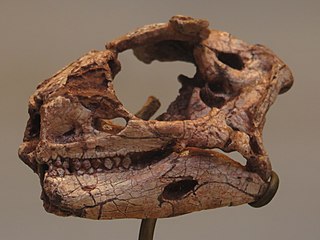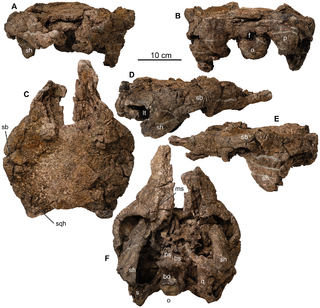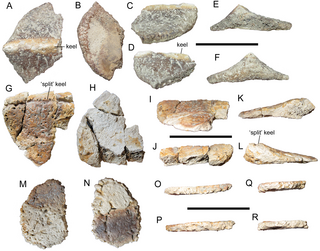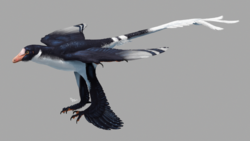
Lesothosaurus is a monospecific genus of ornithischian dinosaur that lived during the Early Jurassic in what is now South Africa and Lesotho. It was named by paleontologist Peter Galton in 1978, the name meaning "lizard from Lesotho". The genus has only one valid species, Lesothosaurus diagnosticus. Lesothosaurus is one of the most completely-known early ornithischians, based on numerous skull and postcranial fossils from the Upper Elliot Formation. It had a simpler tooth and jaw anatomy than later ornithischians, and may have been omnivorous in some parts of the year.

Beipiaosaurus is a genus of therizinosauroid theropod dinosaurs that lived in Asia during the Early Cretaceous in the Yixian Formation. The first remains were found in 1996 and formally described in 1999. Before the discovery of Yutyrannus, Beipiaosaurus were among the heaviest dinosaurs known from direct evidence to be feathered. Beipiaosaurus is known from three reported specimens. Numerous impressions of feather structures were preserved that allowed researchers to determine the feathering color which turned out to be brownish.

Microraptoria is a clade of basal dromaeosaurid theropod dinosaurs. The first microraptorians appeared 125 million years ago in China. Many are known for long feathers on their legs and may have been semiarboreal powered fliers, some of which were even capable of launching from the ground. Most microraptorians were relatively small; adult specimens of Microraptor range between 77–90 centimetres long (2.53–2.95 ft) and weigh up to 1 kg (2.2 lb), making them some of the smallest known nonavialan dinosaurs.

Dyoplosaurus is a monospecific genus of ankylosaurid dinosaur from Alberta that lived during the Late Cretaceous in what is now the Dinosaur Park Formation. Dyoplosaurus represents a close relative of Scolosaurus and Anodontosaurus, two ankylosaurids known from the Horseshoe Canyon and Dinosaur Park Formation.
Kuru is a genus of dromaeosaurid theropod from the Late Cretaceous Barun Goyot Formation of Mongolia. The genus contains only a single species, the type species Kuru kulla, which is known from a fragmentary skeleton including a partial skull.

Huabeisaurus was a genus of dinosaur from the Late Cretaceous. It was a sauropod which lived in what is present-day northern China. The type species, Huabeisaurus allocotus, was first described by Pang Qiqing and Cheng Zhengwu in 2000. Huabeisaurus is known from numerous remains found in the 1990s, which include teeth, partial limbs and vertebrae. Due to its relative completeness, Huabeisaurus represents a significant taxon for understanding sauropod evolution in Asia. Huabeisaurus comes from Kangdailiang and Houyu, Zhaojiagou Town, Tianzhen County, Shanxi province, China. The holotype was found in the unnamed upper member of the Huiquanpu Formation, which is Late Cretaceous (?Cenomanian–?Campanian) in age based on ostracods, charophytes, and fission-track dating.

Peloroplites is a monospecific genus of nodosaurid dinosaur from Utah that lived during the Late Cretaceous in what is now the Mussentuchit Member of the Cedar Mountain Formation. The type and only species, Peloroplites cedrimontanus, is known from a partial skull and postcranial skeleton. It was named in 2008 by Kenneth Carpenter and colleagues. Peloroplites was 6 metres long and weighed 2 tonnes, making it one of the largest known nodosaurids, and came from a time when ankylosaurids and nodosaurids were attaining large sizes.

Ceratonykus is a monospecific genus of alvarezsaurid dinosaur from Mongolia that lived during the Late Cretaceous in what is now the Barun Goyot Formation. The type and only species, Ceratonykus oculatus, is known from a fragmentary skeleton, including an incomplete skull, of an adult individual. It was named and described in 2009 by Vladimir Alifanov and Rinchen Barsbold. Its describers questioned the traditional placement of alvarezsaurs in Theropoda, instead suggesting they were ornithischians, but this has not been accepted since. Ceratonykus has an estimated length of 75 centimetres and weight of 760 grams. It has been considered as a possible junior synonym of Parvicursor.

Tianyuraptor is a genus of short-armed dromaeosaurid dinosaur that lived during the Early Cretaceous, about 122 million years ago. Its remains have been found in western Liaoning, China. It was similar to other dromaeosaurids found in Liaoning, with the exception of being somewhat more primitive. The type specimen, formally named in 2009, shows features not seen in previously known Northern Hemisphere (Laurasian) dromaeosaurids, but present in Southern Hemisphere (Gondwanan) species and early birds. Because of this, the scientists who first studied Tianyuraptor described it as a "transitional species", bridging the gap between northern and southern types of dromaeosaurid. Tianyuraptor also differs from previously known dromaeosaurids in that it possesses a relatively small furcula ("wishbone"), and unusually short forelimbs.

Atacamatitan is a genus of titanosaurian sauropod dinosaurs from the Late Cretaceous Tolar Formation of Chile.

Albertadromeus is an extinct genus of orodromine thescelosaurid dinosaur known from the upper part of the Late Cretaceous Oldman Formation of Alberta, Canada. It contains a single species, Albertadromeus syntarsus.

Europelta is a monospecific genus of nodosaurid dinosaur from Spain that lived during the Early Cretaceous in what is now the lower Escucha Formation of the Teruel Province. The type and only species, Europelta carbonensis, is known from two associated partial skeletons, and represents the most complete ankylosaur known from Europe. Europelta was named in 2013 by James I. Kirkland and colleagues. Europelta has an estimated length of 5 metres and weight of 1.3 tonnes, making it the largest member of the clade Struthiosaurini.

Chuanqilong is a monospecific genus of basal ankylosaurid dinosaur from the Liaoning Province, China that lived during the Early Cretaceous in what is now the Jiufotang Formation. The type and only species, Chuanqilong chaoyangensis, is known from a nearly complete skeleton with a skull of a juvenile individual. It was described in 2014 by Fenglu Han, Wenjie Zheng, Dongyu Hu, Xing Xu, and Paul M. Barrett. Chuanqilong shows many similarities with Liaoningosaurus and may represent a later ontogenetic stage of the taxon.

Jianianhualong is a genus of troodontid theropod dinosaur from the Early Cretaceous of China. It contains a single species, Jianianhualong tengi, named in 2017 by Xu Xing and colleagues based on an articulated skeleton preserving feathers. The feathers at the middle of the tail of Jianianhualong are asymmetric, being the first record of asymmetrical feathers among the troodontids. Despite aerodynamic differences from the flight feathers of modern birds, the feathers in the tail vane of Jianianhualong could have functioned in drag reduction whilst the animal was moving. The discovery of Jianianhualong supports the notion that asymmetrical feathers appeared early in the evolutionary history of the Paraves.

Corythoraptor is a genus of oviraptorid dinosaur from the late Maastrichtian Nanxiong Formation of South China. It contains one species, C. jacobsi, known from a single well-preserved skeleton, and named after paleontologist Louis L. Jacobs. It bears a tall crest similar to that of the modern cassowary, and possibly had a similar functionality of display and resonance to detect lower-frequency sounds.

Daliansaurus is a genus of small troodontid theropod dinosaur, measuring approximately 1 metre long, from the Early Cretaceous of China. It contains a single species, D. liaoningensis, named in 2017 by Shen and colleagues from a nearly complete skeleton preserved in three dimensions. Daliansaurus is unusual in possessing an enlarged claw on the fourth digit of the foot, in addition to the "sickle claw" found on the second digit of the feet of most paravians. It also has long metatarsal bones, and apparently possesses bird-like uncinate processes. In the Lujiatun Beds of the Yixian Formation, a volcanically-influenced region with a cold climate, Daliansaurus lived alongside its closest relatives - Sinovenator, Sinusonasus, and Mei, with which it forms the group Sinovenatorinae.

Nochnitsa is an extinct genus of gorgonopsian therapsids who lived during an uncertain stage of the Permian in what is now European Russia. Only one species is known, N. geminidens, described in 2018 from a single specimen including a complete skull and some postcranial remains, discovered in the red beds of Kotelnich, Kirov Oblast. The genus is named in reference to Nocnitsa, a nocturnal creature from Slavic mythology. This name is intended as a parallel to the Gorgons, which are named after many genera among gorgonopsians, as well as for the nocturnal behavior inferred for the animal. The only known specimen of Nochnitsa is one of the smallest gorgonopsians identified to date, with a skull measuring close to 8 cm (3.1 in) in length. The rare postcranial elements indicate that the animal's skeleton should be particularly slender.

Invictarx is a monospecific genus of nodosaurid dinosaur from New Mexico that lived during the Late Cretaceous in what is now the upper Allison Member of the Menefee Formation. The type and only species, Invictarx zephyri, is known from three isolated, incomplete postcranial skeletons. It was named in 2018 by Andrew T. McDonald and Douglas G. Wolfe. Invictarx shares similarities with Glyptodontopelta from the Naashoibito member of the Ojo Alamo Formation, New Mexico.

Dynamoterror is a monospecific genus of tyrannosaurid dinosaur from New Mexico that lived during the Late Cretaceous in what is now the upper Allison Member of the Menefee Formation. The type and only species, Dynamoterror dynastes, is known from a subadult or adult individual about 9 metres long with an incomplete associated skeleton. It was named in 2018 by Andrew T. McDonald, Douglas G. Wolfe and Alton C. Dooley, Jr. Dynamoterror was closely related to Teratophoneus and Lythronax.

Fukuipteryx is an extinct genus of basal avialan dinosaurs found in Early Cretaceous deposits from Japan's Kitadani Formation. It contains one species, Fukuipteryx prima.






















